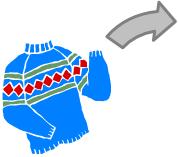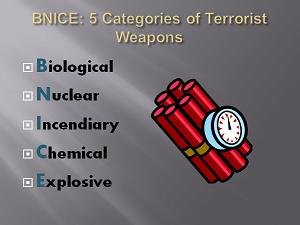Maybe you are a subject matter expert teaching something to a bunch of newbies, or maybe you are an instructional designer working with a subject matter expert. Either way, it’s important to consider the mental models your learners have for the subject. What do your learners already know, and how have they organized that information in their heads?
Thinka about a subject in which you have expertise. What kind of mental model do you have? This kind?

Or this kind?

If you are the expert, it’s likely that you have the first kind of mental model – pretty orderly, with a lot of different categories, distinctions, and a sophisticated way of organizing the information.
So what happens when you start trying to give content to your learners? Well, if somebody hands an expert a blue sweater to put in the closet, that expert will be able to decide pretty quickly where to put that sweater (on the sweater shelf, next to other winter clothing, ordered by weight or style or even color). But when you hand content to a novice learner, that person is likely to look perplexedly at the piece of information that they have no context for, shrug, and toss it onto the pile of other information accumulating on the floor of their closet. We’ve all had those training experiences where you get a flood of information, and all you can do is try to keep up.

The bigger problem comes when you want someone to retrieve the information. As the expert, you have all sorts of ways to pull out a particular piece of information – check sweaters, check winter clothing, check casual wear, or check things that are blue. At the same time your learner is pawing randomly through their pile, with no other strategy than to try really hard to remember.
So what do you do about this? Well, the first thing you need to do is help your learners build a few shelves. There’s no way that any single class or training program is going to get them all the way to your mental model, and you shouldn’t try (that’s just as bad as burying them under a flood of multi-colored laundry). But you can definitely give them some context for the information that you are going to give them.

Here are a few ways help your learners do that:
- Use a high-level organizer – give them a high level organizer that gives them a few shelves to start with. This could be a road map of the broad categories, or an overview of the basic principles. Or it could be an acronym or a mnemonic device.

- Use visuals – visual information contains several extra cues that give your learner many more hooks for storing and retrieving the information.

- Use a story – people have amazingly sticky memories for well-told stories, particularly ones that arouse emotions.

- Use a metaphor – compare it to something that your learners are already familiar with, so you can leverage the storage and retrieval capability of one of their existing mental models. It’s frequently a good idea to use something common and everyday that the learner can’t help but be familiar with – like, oh say – a closet.


Your closet metaphor for organizing content when designing materials truly makes a valid point. Instructional designers must be experts in the content area or work closely with one so that they know which bit of information belongs where. However, individuals may vary in their real life closet organization just as they may in the organization of their knowledge storage. I believe that is where providing them with a “shelf” to begin a high level organizer could link the commonalities among the individual learners so that everyone benefits from the material.
I really enjoyed your brain-as-closet metaphor. This is a great explanation for storing and retrieving information and knowledge. I love the way you equate learning through context to building shelves. I believe that the most effective learning happens when it occurs through building contexts from which one can draw conclusions. Certainly there are other ways to learn; but building bridges of understanding through contextual methods, such as story-telling, visual aides, and metaphors are generally very successful. Kudos to you for building this metaphor; it is one that I will not soon forget.